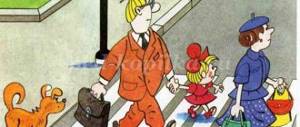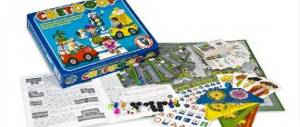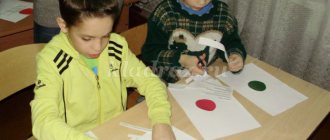TEAM GAMES
CROWS AND SPARROWS
A line is drawn in the middle of the site. The players are divided into two teams. They stand in ranks at a distance of one meter from the center line, after which they turn their backs to each other.
Lines of houses are drawn 15-20 steps away from each team. Thus, each team faces its own house. The teams get names: one of them, for example, is called “crows”, the other is called “sparrows”.
The leader stands on the side between the teams. After a short pause, he says the name of one of the teams. This team turns around and tries to catch up and harass the players of the opposing team who are running beyond their home line.
When pronouncing the name of the team, the leader pronounces it loudly and in syllables, for example: “Vo-ro-ny!” or “Whoa!” Only having caught the last syllable, players in teams must quickly figure out what to do: run away or catch up.
The leader shouts out both of them several times and does not necessarily alternate names.
The winner is the team that manages to catch more players in an equal number of runs.
KEEP A TOWN
Draw two lines at a distance of 20 steps from one another. These are the lines of “cities” behind which the teams are located. Participants in teams are counted in numerical order. A stool is placed in the middle of the site, on which an object (a town or a ball) is placed.
Knock down the town
When everything is ready, the game begins. The manager calls the number loudly. Players from both teams with this number rush into the field. They run to the edge of the opposite city. Having stepped on it with their foot, they make a quick turn, and on the way back, each of them tries to be the first to knock the little town (ball) off the stool with his hand. The one who manages to do this brings his team 1 point.
Then the leader calls another number, a third, etc. If any numbers touch the town at the same time, then both teams are awarded 1 point.
When all players are called once, the result is summed up. The team with the most points wins.
WHO WILL PULL WHOM?
All participants in the game are divided into pairs in such a way that in each pair the players are approximately equal in strength. If the squad is mixed, then boys and girls stand in pairs separately.
Who will pull who?
A long line is drawn on the ground. The couples stand along it. Thus, two teams are formed: one on one side of the line, the other on the other. The distance between them is 1 step.
At the leader’s signal, the players join hands in pairs. At the second signal, everyone tries to pull their opponent over the line.
The one who steps over the line with both feet is considered a prisoner and leaves the game, and the one who pulled him over can now help one of the players of his team: by wrapping his arms around him from behind, together with him he can pull the struggling opponent. The team that takes the most prisoners is considered the winner. The game can be played two or three times.
SHUTTLE
This game will help determine who in the team is the best long jumper. To conduct the competition, participants are divided into two teams of equal numbers of players. The number of boys and girls (if the teams are mixed) must also be equal.
The pioneers are lined up in two lines facing each other and are counted in numerical order. A line is drawn across. It is agreed that the players in the teams will jump in turns (through one) and in opposite directions.
The competition takes place as follows. At a sign from the leader, the first number of one of the teams approaches the line, places his feet so that the toes touch the line and the feet are parallel. The player jumps as far forward as possible. The leader or one of the players marks the player’s landing spot (on the heels) with a line on the ground or chalk on the floor.
Then the other team's first number comes out. He stands with his feet where the previous one landed and jumps in the opposite direction. If he jumped over the starting line and landed beyond it, it means that he won a few centimeters for his team from the previous opponent, and vice versa. The place where the heels of the jumper ended up is also marked with a line. After this, the representative of the first team jumps again in the opposite direction, etc.
The last jump is always made by the team opposite the one that started. If the last player manages to cross the halfway line, his team wins as many centimeters (or feet) as the distance from his landing line to the halfway line. If he does not jump to the middle, then the team loses the corresponding segment to the enemy.
JUMPERS AND RUNNERS
For the game, a square of approximately 8 X 8 m is outlined. The players are divided into two equal in the number of players and the strength of the team. By lot, one of them is called “jumpers”, and the other is called “runners”. Each team chooses a captain.
Jumpers and runners
The runners enter the square that is their home. Jumpers line up near the runners' house. The manager marks the time on the clock. After this, the captain of the jumpers sends his players into the field one by one, who, jumping on one leg (it is prohibited to step and change legs), try to spot the players of the opposite team, who are running freely (on two notes) around the court.
Each jumper is in the field for 10 - 15 seconds and after the command of his captain: “Home!” - comes back. The exhausted runners leave the court and remain outside it until all other players are caught. Then the teams change roles and the game is played again. The winner is the team that spends the least amount of time eliminating the opposing team's players from the game.
According to the terms of the game, the same jumper can enter the field several times if the captain sends him out. Players of both teams are prohibited from going beyond the square. Otherwise, the runner is considered to have been stung, and the jumper who chased him returns beyond the line and does not participate in the game anymore. Since the game is tiring for the jumpers, the manager must ensure that the captains of the jumping teams bring their players home more often, and send new players into the field.
Leapfrog relay race
This is a folk game, played mainly by boys.
1st option. Participants are divided into two teams, each of which lines up in a column. The distance between participants in the column is 8 - 10 steps. A line is drawn before the first and last numbers in the columns.
All players in columns, except those standing behind, put their leg forward, leaning on it with their hands, and, tilting their torso forward, remove their head.
At the leader’s signal, the players standing last step back a little, run up and jump one by one over all the players in their column. At the same time, they rest their hands on the backs of the players and spread their legs to the sides. When the player has finished jumping, that is, has jumped over all the guys in sequence, he takes 6 steps forward and becomes bent over, like everyone else playing. This serves as a signal to the second player, who was the last one in the column. He also begins to jump over everyone in front. Then third numbers jump, etc.
The competition between teams ends when all players in the teams complete the exercise. The team that does it faster than the rest wins.
Jump over everyone in front
2nd option. You can play on a small area. The players, divided into three teams, line up in columns. A line is drawn before the toes of the first numbers. In front of each column (at 8 - 10 m) squares are drawn (dimensions 2X2 m).
Drawing for the relay-train game
The first players in the columns come forward and take places in the squares. They stand in the position described in the previous version, that is, so that it is not difficult to jump over them.
At a sign from the leader, the players standing first in the columns run forward and jump, leaning on their hands, over those standing in the square. After this, they themselves take their place, taking the appropriate pose. The one who was jumped over quickly runs back to his column, and, hitting the hand of the player standing in front, he himself stands at the end of the column. The touched player runs forward and also jumps over the player standing there. Thus, everyone who jumps over remains in the square, and the one who was jumped over runs back.
The leapfrog relay ends when the player who stood first returns to the square. The team that completes the task first wins.
RELAY-TRAINS
All players are divided into two or more equal teams, each with 8-12 people. Teams line up in columns at a distance of 3-4 steps from one another. A line is drawn before the first numbers in the columns.
The game begins at the general signal. The players standing first run to the left around their team, run around it and, returning to their place, take the next one with them. Now two players run around the teams, one after another. In the same way, they add a third, then a fourth player. The number of cars in each train is increasing. When the front player - the driver - with the full complement returns to his place (to the line), he raises his hand.
The team that manages to complete the train before others wins.
Players must comply with the rules of the game; During the competition, do not move from your place and attach yourself to the train alone.
The first player in the column must run to the line each time and only after that go back behind the rest of the players.
COUNTER RELAY WITH HOOPS
The participants of the game are divided into two teams and lined up in two columns. Each team, in turn, is divided in half. Both groups line up opposite each other at a distance of 10 - 20 steps (depending on the size of the site). A line is drawn in front of the toes of the first numbers on each side of the court.
Counter relay with hoops
In the middle of the site (on the line) one hoop is placed in front of each column. At a signal from the leader, the first number in one of the columns runs forward, reaches the hoop, climbs through it, leaves the hoop in the same place and continues running. Having reached the opposite column, he hits the palm of the first number of this column, and he himself stands behind. This serves as a signal for the first numbers of this column to continue running, who rush forward and do the same exercise.
The relay ends when all players run to the opposite side, having first climbed through the hoop. The team that completes the task first is considered the winner.
In the second version of this game, the players standing opposite in columns are settled in order.
The first numbers standing in each column opposite each other are given one hoop. Thus, if two teams are participating in a game, four hoops are needed.
At the leader’s signal, players with hoops (in each team) run towards each other. Having caught up, they change hoops, climb (in the middle of the site) through them, and then continue running to the opposite columns. Having given the hoop to the players standing in front, they themselves stand at the end of the column. The players who received the hoops also run forward, exchange hoops among themselves, climb through them and continue running to the next numbers, etc.
RELAY RACE WITH STICK AND JUMPING
Participants are divided into two or three teams and are located in columns 3-4 steps from each other. A line is drawn before the first numbers in the columns. Circles with a diameter of 30 cm are drawn 8 - 10 m in front of each column. The first numbers in the columns take one gymnastic stick (80 - 100 cm long).
Relay race with sticks and jumps
At a sign from the leader, the first players in the columns rush forward. Running up to their circle, each of them puts a stick in it and, without letting go of the other end, runs around the circle completely. After that he comes back with the stick. Stopping on the left side of the second number in the column, the player passes him the other, free end of the stick. Both players then move to the end of the column, carrying the stick under the feet of all players. The latter carefully monitor the movement of their comrades carrying a stick and jump over when it passes under their feet.
The first number remains at the end of the column, and the second runs with a stick to his team’s circle, puts the stick down and, having run around it, returns to the third number to carry the stick back with him. Then the third number performs the exercise, the fourth, etc.
The relay ends when the first numbers are again in front of the column. They raise the sticks brought by the last numbers up. The team that does this before the others wins, unless, of course, it violated the established rules (all players jumped over the stick in sequence and did not drop the stick on the ground). For these violations, teams are given penalty points, which reduces their chances of winning.
SNIPERS
The rectangular area is divided by the middle line into two squares, each of which houses a team of 10 - 12 people. To play you need a volleyball.
Captains are selected. After the play between them, the ball is passed to one of the teams, which tries to knock out the opposing player with a well-aimed blow (without crossing the center line). The one who was hit by the ball leaves his square and runs to the opponent behind the far end line. The ball remains with the team that lost the player. She, in turn, tries to knock out the opposing player. A hit after bouncing off the ground does not count.
As the game progresses, more and more captives become behind the teams, who try to pick up the ball that has flown out of bounds and pass it to their team.
Prisoners can be rescued by throwing a ball to one of them (over the enemy's heads). If the ball is caught from the air, the prisoner throws the ball to his team and returns to his team. If the ball was only lifted from the ground, then the prisoner does not help out.
The game is played against time. After ten minutes the teams change sides of the court and the game continues.
FOOT FOOT
One of the short sides of the site is called the city, the opposite side is called the horse. A circle with a diameter of 6 m is drawn in the center of the site, a pole 1.5-2 m long is placed in it. Two teams of 8-12 people play.
By lot, one team goes beyond the city line. Players stand differently at the direction of their captain on and off the court.
Players in the city take turns kicking the soccer ball from the city line, trying to get it to land as far into the field as possible. When struck, it is not allowed to go beyond the city line. The player who hits the ball runs to the line, and having reached it, he must return back to the city.
Players on the field try to quickly catch the ball and hit
them into the pole, without going beyond the line surrounding the pole. If the ball hits the pole while a player from the city team is in the field, before reaching the stake line and then returning to the city, the city team loses one point and the player who runs over is eliminated from the game.
If, before the ball hits the pole, the person running across manages to reach the line of the horse and return back to the city, then the city team gets a point. The player who returns to the city is entitled to one more hit.
When the city team does not have a single player who has the right to strike, the teams change places. The game continues until one of the teams scores a set number of points.
BREAK THE WALL
This game is designed for boys. It will help them learn how to accurately kick the ball, stop it and pass it to their partners. Therefore, the game is especially useful for young football players.
An area of 20 X 30 m is divided by a transverse line into two fields. The participants of the game form two teams, each of which occupies one half of the field. The players are arranged in a checkerboard pattern. During the game, they do not have the right to step beyond the center line of the field into the opponent’s half.
Two balls
The referee puts the ball into play in the middle of the field by hitting the ground. The ball bounces to one of the teams, its player passes the ball to a partner with his foot or hits the ball himself so that it passes through the entire half of the opponent’s field and rolls out beyond its back line. If this is achieved, the kicking team receives one point and the game begins from the center of the field.
But the opposing players build a kind of wall; they try to hold the ball with their feet, stop it, and then, in turn, try to break through the living wall, which is formed by the players of the opposing team.
The first half of the game lasts 15 minutes. Then the teams change sides of the court and the game is repeated. The team with the most points wins.
It is important that during the game the guys follow the following rules: stop the ball with any part of the body, with their heads, but do not grab it with their hands. When hitting the ball, players should not lift it above their waist. For these violations, the ball is given to the opposing team and the point is not counted.
TWO BALLS
Two teams of 6 to 10 people play on the volleyball court. The site is divided in half by a net or rope with flags, stretched at a height of up to 2 m (170 - 200 cm). To play you need two volleyballs.
Each team is located on one half of the court. Players stand in a checkerboard pattern to protect as many areas of the field as possible. The initial throw can be made by any player who is no closer than 3 m from the net at the direction of the captain.
This initial throw is made simultaneously by two players from different teams after the referee's whistle. Each of them throws the ball over the net to the opponent's side. After this, the task of each team is to quickly catch the ball or pick it up from the ground and throw it back over the net again. To win a point, you need to have two balls in the opponent's half at the same time. In this case, they must either touch the floor or be in the hands of the players. If this happens, the referee blows the whistle, the balls are again distributed between the two teams, and the game continues.
The team that scores 10 points faster wins. This game can consist of three games, like volleyball. The game also retains some of the rules of volleyball. For example, you cannot kick the ball under the net or step beyond the center line during the game. During the initial throw, the ball should also not touch the net. Throws must be made accurately and the ball must not land outside the opponent's court line.
If a team violates these rules, then its opponent is awarded one winning point. In the game, participants can change places on the court, that is, make a transition, as in volleyball.
This game can be played as a preparatory game for a game of volleyball. In this case, the players make the serve (the first hit), as in volleyball, that is, they throw the ball up, then hit it with the palm of one hand. If the serve is unsuccessful and the ball does not go over the net, the team loses a point.
You can play the game not only with two, but also with four balls. Then the team that has three balls on its side at the same time loses the point. However, this option should be introduced when the children master the game with two balls.






